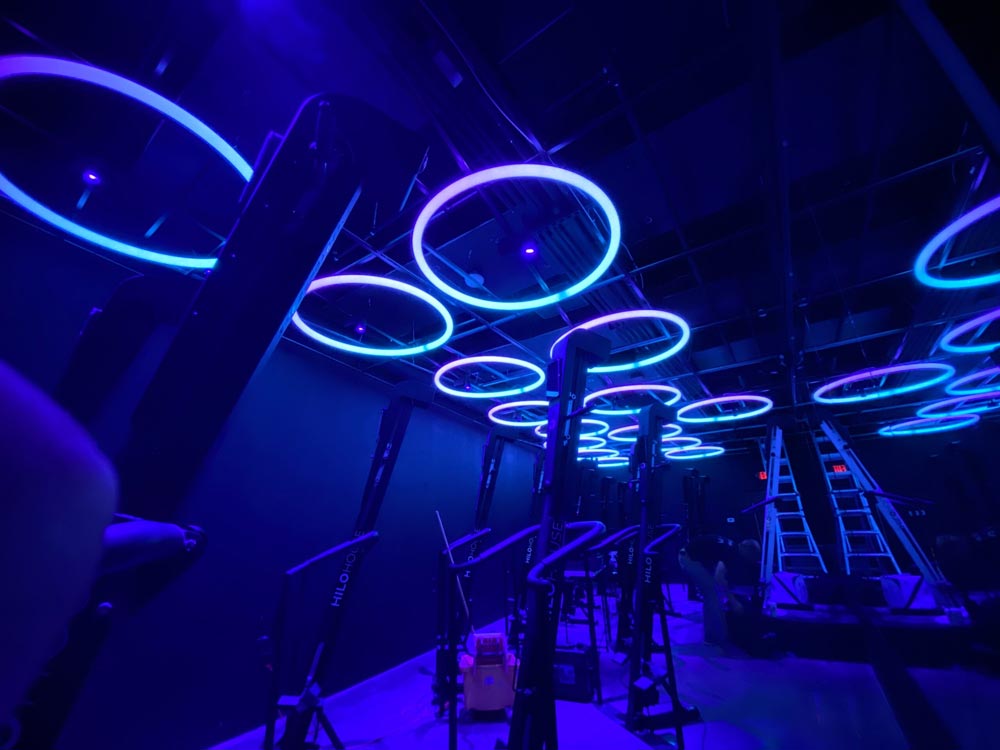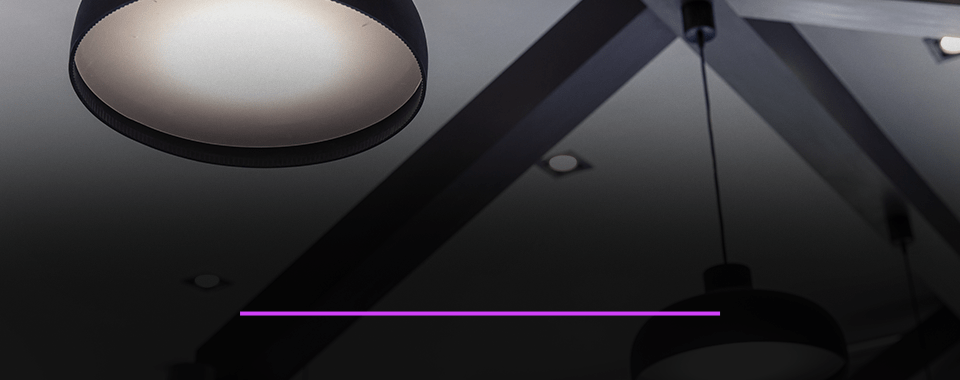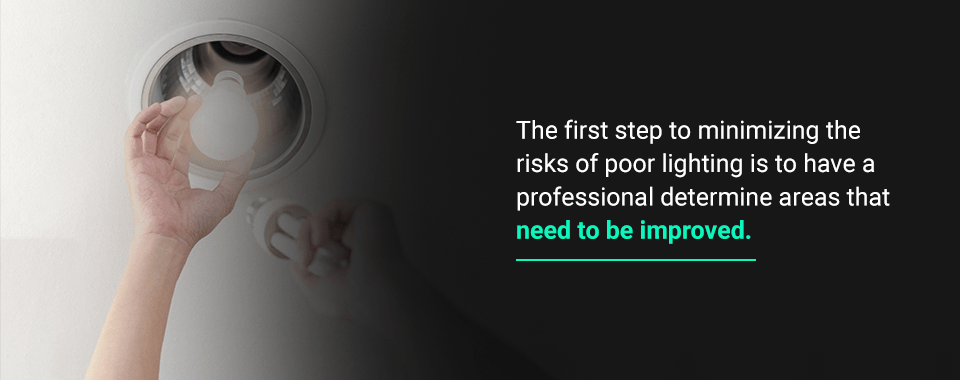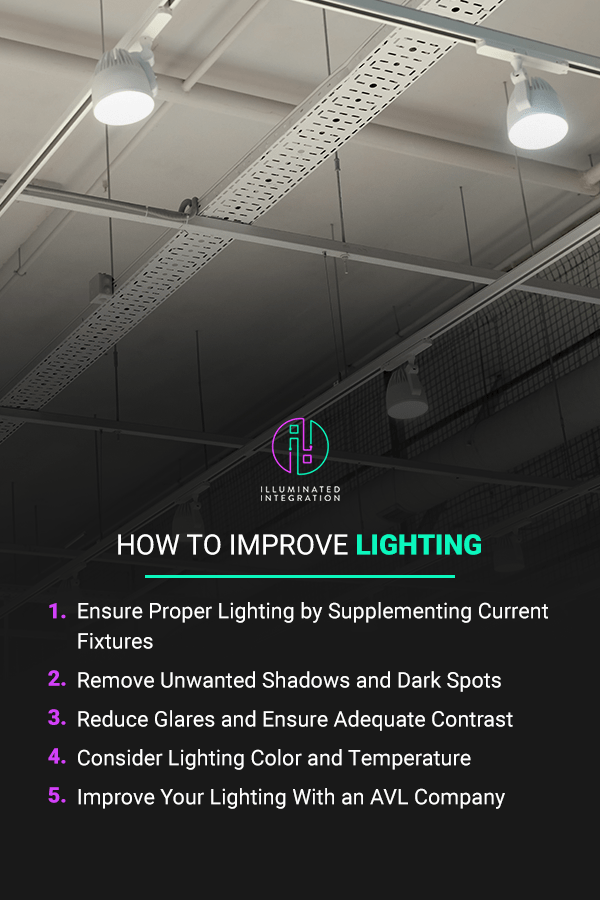

Working in any type of building with poor lighting can be really frustrating. Working in the corporate world means your employees likely rely on screens and monitors all day to perform their jobs, which can become taxing on the eyes and neck. If your workplace has insufficient light, your workers’ eyes may be constantly adjusting to drastic lighting changes, which can cause them to feel tired and distracted at work. Bad lighting can result from poor design, outdated systems or a lack of natural light.
Insufficient light in your space can reduce productivity and even lead to a range of health issues, such as poor posture and eye strain. These issues can make it uncomfortable for workers to spend long periods of time in your building. Not to mention, you run the risk of injury if your space is not well-lit. You can improve the lighting in your workplace and make it much more intentional and inviting with the tips in this article.

Proper workplace lighting is critical for many reasons. Firstly, it makes all tasks easier. When light levels are too low, high or inconsistent, it impairs your workers’ ability to complete tasks efficiently and creates a safety issue. Here are the major effects of poor lighting in the workplace.
One of the first signs you may notice of having insufficient light in your workplace is eye strain. In poorly lit spaces, our eyes tend to work harder to see, which can cause discomfort, burning and soreness. Eye strain can also occur in areas where the light is too bright or strong or if it flickers consistently. This can become uncomfortable for your employees and workers who spend a great deal of time in your workplace.
Eventually, their quality of vision can deteriorate, especially if they’re working with computers or screens without adequate lighting. Consistent eye strain can also lead to tearing, irritated, red or dry eyes, which can make your workers feel more tired and stressed. Overall, this can impair their productivity and efficiency at work.
Similar to eye strain, one of the most common effects of poor lighting in the workplace is headaches. Headaches may also occur on their own as a result of working for long periods without adequate light. For instance, working in a school or museum with poor lighting can make it difficult for your workers to do their jobs.
If your employees and business partners are dealing with consistent headaches from dim lighting, it can reduce their efficiency and cause serious pain and discomfort. Staring at blue light from computer screens for hours every day can already cause discomfort to the eyes, brain and body, so adding insufficient light to the mix may cause more damage.
In addition to headaches, your workers may also experience neck, back and shoulder pain if they have to hunch over and strain to see items as a result of incorrect lighting design. This means your workers may have to sit in uncomfortable positions for a long time or remain in an awkward position to get close to their desk lamp lighting. These issues can worsen over time and result in health issues.
Poor lighting can result in mistakes, errors and low accuracy. Bad lighting can also make your workers feel sluggish and tired, reducing the quality of their work and reducing the efficiency of your work environment. All of these elements directly impact worker productivity which can put your business or organization behind on operations. With bright, proper lighting, employees have a better ability to focus and concentrate on their tasks.
One of the most dangerous effects of poor lighting is workplace injuries and accidents. If you’ve ever been in a poorly lit space, you know it can be difficult to estimate the size, shape, depth or proximity of objects around you. Poor lighting can create many safety hazards for your employees and make it difficult for them to see.
This means it’s more likely for accidents to occur, such as tripping, falling or slipping. If your building has a dimly lit stairwell, or if your workers tend to use various materials and tools, this can become an even bigger liability factor for your business.
There are plenty of health hazards of poor lighting, but these effects also impact our mental well-being. Research shows that poor lighting has negative effects on our mental health. Working in gloomy or insufficient lighting for extended periods, such as at work every day, can make your workers feel depressed, tired and stressed.
Over time, it may even influence their level of satisfaction at their jobs. All of these factors can have a negative impact on your business or organization’s performance. By consulting with experts who can perform a lighting risk assessment, you can install proper lighting and improve your workers’ overall well-being.

The first step to minimizing the risks of poor lighting is to have a professional determine areas that need to be improved. Parts of your building can appear dark if the light is not dispersed evenly and create significant fluctuations which cause your workers’ eyes to compensate. Here are some of the most common lighting problems you may be experiencing in your workplace:
If you’re working in an office space or area with individual workstations, be sure to have your employees remain in their normal positions to give you accurate results:
In corporate settings, you may be able to easily identify glares and improper contrast as they appear on reflections on glass, monitors and other areas that can create discomfort for employees.

Now that you know a few ways to identify and find the cause of poor lighting, such as glares and improper contrast, let’s look at how you can improve the lighting situation in your workplace.
The first step to improving your workplace lighting is to check whether there is adequate lighting in all areas to prevent your workers’ eyes from having to work harder. If you have natural lighting in your space, consider moving furniture around so your workers’ can access that light as much as possible during the day. You can also choose lightbulbs with a brighter light, adjust your light fixtures to avoid shadows and glares and create more light concentration in important areas.
To correct insufficient light, be sure to replace your bulbs and clean your light fixtures on a regular schedule. Add more light fixtures in appropriate places, such as areas where employees are working on a task. However, take care to position your lights intentionally, and do not place them directly facing or behind the worker, as this can create unwanted eye strain and shadows. Finally, if you have tall ceilings, distribute some light upwards to avoid closing in the space.
The next step to improving lighting in your space is to actively remove shadows and dark corners in your environment. Dark spots in your workplace can create illumination imbalance, which forces your workers’ eye muscles to constantly expand and contract to adapt to the amount of light in each area. This can lead to headaches and eye pain. If your employees work in a relatively dark area with only their bright monitors or tablets for light, it can create vision problems as they utilize other areas of the space.
Use a mixture of direct and indirect lighting to eliminate these dark spots and ensure all workstations are evenly illuminated. Pay attention to areas in your environment that don’t contain a specific object, such as corners, ceilings or walls. Putting consistent lighting in these areas can create a more even distribution of light.
Glare is caused by reflections on glossy surfaces or bright lights that aim directly at your employees’ line of sight. This makes it difficult to adjust to anything outside of the brightest light, making darker areas hard to see. Even natural lighting from windows can create indirect glares as it reflects the vision field from various surfaces.
To reduce direct and indirect glare, you can add window treatments to block direct sunlight as needed throughout the day, such as blinds, shades or sheer curtains. You can also rearrange your office furniture to ensure no monitors or reflective surfaces are directly below an overhead light fixture. Some workers may even regulate their monitor brightness and filter out blue light to ease the strain on their eyes.
All workspaces have unique aspects and architecture, so it’s important to reflect on what your workplace specifically needs. These needs can depend on the number of workers you have in a space, how much natural lighting you receive and how the colors of the walls and furniture in the space affect your lighting choices. Certain lighting colors have different effects on mood and productivity. For instance, excessive exposure to artificial lighting can disrupt a person’s circadian rhythms, which can influence their sleep patterns, energy and productivity.
White tuning, on the other hand, allows you to adjust the white color temperature and intensity of light in a room. Being able to adjust your lighting according to the different times of day and the amount of natural light that comes through your office can help your employees feel more alert and boost their mood.
If you’re looking to enhance the lighting in your workspace, school or venue, it can be a challenge to figure out which lighting fixtures you need and how to avoid glares, shadows and other lighting problems. Partnering with an audio, video and lighting (AVL) company allows you to build your unique project from the ground up. Though many light fixtures may serve a universal purpose, they shouldn’t be used as a one-size-fits-all solution. Your business or organization has distinct needs.
Working with an AVL company enables you to rely on professionals who know the impact of lighting design and can prevent issues down the road. After all, it may seem enticing to do everything yourself at first, but you may have to fix mistakes and end up with more costs in the end. Establishing a quality lighting system in your corporate space can improve efficiency and provide you with a hassle-free experience.
Lighting is one of the most crucial elements in any workplace. With a distracting glare, improper contrast or flickering lights, your space can become an eyesore for employees and can even lead to safety hazards and injury. At Illuminated Integration, it’s our goal to help you create a design-build solution that meets the needs of everyone who enters your space. We provide a seamless and unified user experience for every project to ensure every inch of your environment is properly lit.
Our design services aim to improve both the aesthetic and comfort of your workplace, so you can benefit from a welcoming space where workers can maximize their productivity. Contact us today to discover how we can help you improve the lighting in your workspace.